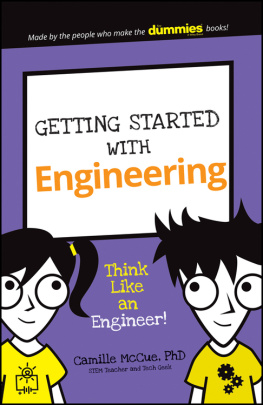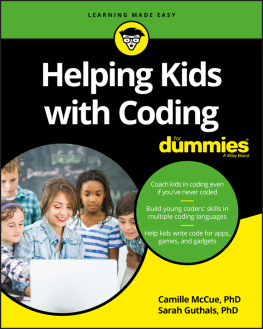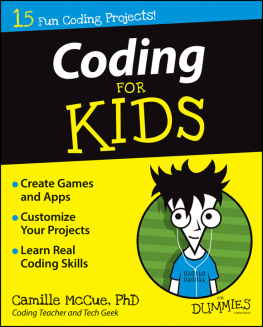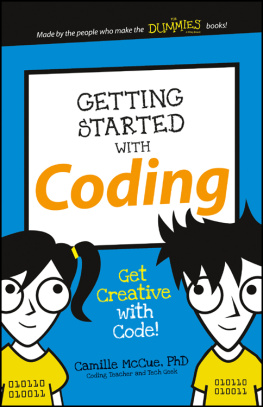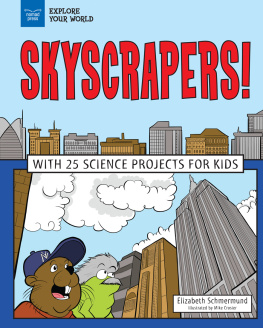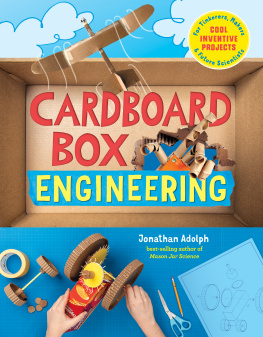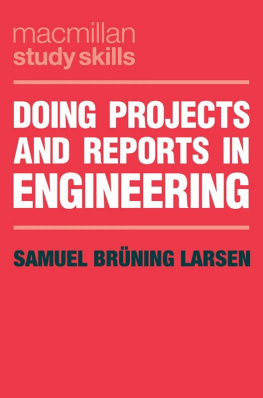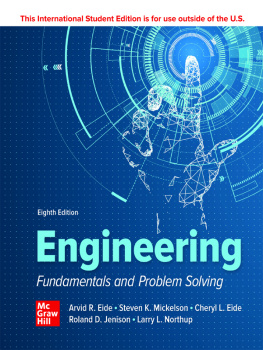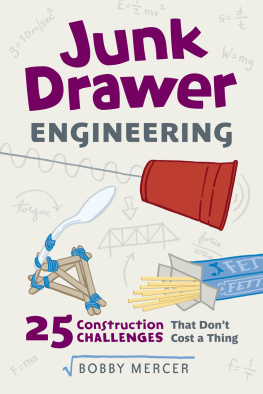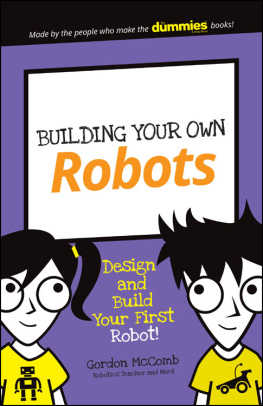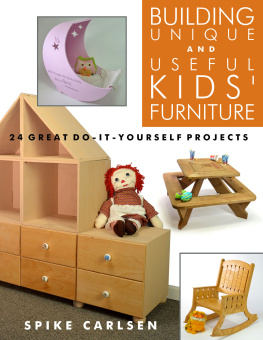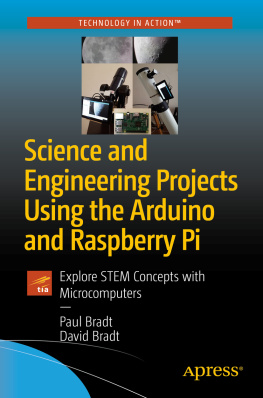

GETTING STARTED WITH ENGINEERING
Published by
John Wiley & Sons, Inc.
111 River Street
Hoboken, NJ 07030-5774
www.wiley.com
Copyright 2016 by John Wiley & Sons, Inc., Hoboken, NJ
Published simultaneously in Canada
No part of this publication may be reproduced, stored in a retrieval system or transmitted in any form or by any means, electronic, mechanical, photocopying, recording, scanning or otherwise, except as permitted under Sections 107 or 108 of the 1976 United States Copyright Act, without the prior written permission of the Publisher. Requests to the Publisher for permission should be addressed to the Permissions Department, John Wiley & Sons, Inc., 111 River Street, Hoboken, NJ 07030, (201) 748-6011, fax (201) 748-6008, or online at http://www.wiley.com/go/permissions .
Trademarks: Wiley, For Dummies, the Dummies Kid logo, Dummies.com, and related trade dress are trademarks or registered trademarks of John Wiley & Sons, Inc. and may not be used without written permission. All other trademarks are the property of their respective owners. John Wiley & Sons, Inc. is not associated with any product or vendor mentioned in this book.
LIMIT OF LIABILITY/DISCLAIMER OF WARRANTY : THE PUBLISHER AND THE AUTHOR MAKE NO REPRESENTATIONS OR WARRANTIES WITH RESPECT TO THE ACCURACY OR COMPLETENESS OF THE CONTENTS OF THIS WORK AND SPECIFICALLY DISCLAIM ALL WARRANTIES, INCLUDING WITHOUT LIMITATION WARRANTIES OF FITNESS FOR A PARTICULAR PURPOSE. NO WARRANTY MAY BE CREATED OR EXTENDED BY SALES OR PROMOTIONAL MATERIALS. THE ADVICE AND STRATEGIES CONTAINED HEREIN MAY NOT BE SUITABLE FOR EVERY SITUATION. THIS WORK IS SOLD WITH THE UNDERSTANDING THAT THE PUBLISHER IS NOT ENGAGED IN RENDERING LEGAL, ACCOUNTING, OR OTHER PROFESSIONAL SERVICES. IF PROFESSIONAL ASSISTANCE IS REQUIRED, THE SERVICES OF A COMPETENT PROFESSIONAL PERSON SHOULD BE SOUGHT. NEITHER THE PUBLISHER NOR THE AUTHOR SHALL BE LIABLE FOR DAMAGES ARISING HEREFROM. THE FACT THAT AN ORGANIZATION OR WEBSITE IS REFERRED TO IN THIS WORK AS A CITATION AND/OR A POTENTIAL SOURCE OF FURTHER INFORMATION DOES NOT MEAN THAT THE AUTHOR OR THE PUBLISHER ENDORSES THE INFORMATION THE ORGANIZATION OR WEBSITE MAY PROVIDE OR RECOMMENDATIONS IT MAY MAKE. FURTHER, READERS SHOULD BE AWARE THAT INTERNET WEBSITES LISTED IN THIS WORK MAY HAVE CHANGED OR DISAPPEARED BETWEEN WHEN THIS WORK WAS WRITTEN AND WHEN IT IS READ.
For general information on our other products and services, please contact our Customer Care Department within the U.S. at 877-762-2974, outside the U.S. at 317-572-3993, or fax 317-572-4002. For technical support, please visit https://hub.wiley.com/community/support/dummies .
Wiley publishes in a variety of print and electronic formats and by print-on-demand. Some material included with standard print versions of this book may not be included in e-books or in print-on-demand. If this book refers to media such as a CD or DVD that is not included in the version you purchased, you may download this material at http://booksupport.wiley.com . For more information about Wiley products, visit www.wiley.com .
Library of Congress Control Number: 2016943219
ISBN: 978-1-119-29122-0 (pbk); 978-1-119-29128-2 (ebk); 978-1-119-29129-9 (ebk)
Getting Started with Engineering
- Table of Contents
Guide
Pages
INTRODUCTION
SO YOU WANT TO GET STARTED WITH ENGINEERING! Engineers are people who design and invent new products and processes. They improve life by building solutions to problems in the natural world. They use tools and technologies in their daily work. And they team up on projects with scientists, government officials, and business people.
Many grand challenges await you in the world of engineering: making better use of solar energy; creating new types of transportation; securing cyberspace; designing better medicines; providing the world with clean drinking water; applying the function of the brain to computers; inventing new ways to teach people; and improving virtual reality. Its never too early to start, so roll up your sleeves and get ready to work as a junior engineer!
ABOUT THIS BOOK
Engineering is a hands-on field. When you work in engineering, you will use your body as much as you use your brain. In this book, you have opportunities to do both! Sometimes you'll use your eyes and your fingers to work in a small, careful way. An example is using a needle and thread to sew a wearable electronic circuit with LED lights and a battery onto a baseball cap. Other times, you'll use your lungs, legs, and arms to work in a big, athletic way. An example is blowing up balloons to serve as air bags on a Mars lander, and then running up the stairs and hurling the lander off the second floor to (what I hope is) a soft landing on the planetary surface below.
But you'll also use your brain quite a bit. You'll do some online research to learn about engineering projects that have been done before and how they succeeded or failed. You'll use computer simulations to tinker with a product or a process to learn how it operates. In this way, you can try different ways of building or different ways of conducting a process before you do them in the real world. You'll brainstorm and draw design plans in your design notebook and then write down how those plans perform and how you can improve them.
Heres what you need to do the projects in this book:
- A computer running a modern version of a Windows or Mac OS X operating system
- A reasonably fast Internet connection
- Some household items, such as foil pans, scissors, a trash bag, tape, a marble, a meter stick, clear plastic wrap, tape, a dog leash, kitty litter, cotton balls, an ear syringe, a thermometer, liquid dishwashing soap, and a kitchen scale (plus a few more items)
- Some food items, such as marshmallows, graham crackers, canola oil, and assorted pasta
- Some home improvement store items, such as foam tubing, PVC elbows, string, sand, and perlite
- Some craft store items, such as craft foam, pipe cleaners, hay, a hot-glue gun, feathers, and faux fur
- One specialty purchase (LilyTwinkle electronics kit for $20) and, optionally, the use of a 3D printer
- Some safety gear, namely goggles, protective gloves, and a face mask

Courtesy of Logovski/Getty
- One design notebook, which can be any notebook with paper or graph paper, to draw designs and write evaluations of your products and processes and how to improve them; you can also print photos of your work and paste them into your notebook (optional)
If youre reading this as an ebook, you can click web addresses, such as www.dummies.com , to visit that website.
Every project follows the Engineering Design Cycle, or Engineering Cycle. This process is different from the Scientific Method, which you probably learned in school. I explain the Engineering Cycle in .
My design sketches are meant to spark your imagination. Your engineering designs may look very much the same or very different from my designs. Your ideas are valuable and I want you to have faith in them. Brainstorm, invent, and build!
Finally, every project wraps up with a section called the Iron Triangle of Engineering. This section helps you think about what real engineers consider when doing that type of project.
Next page
